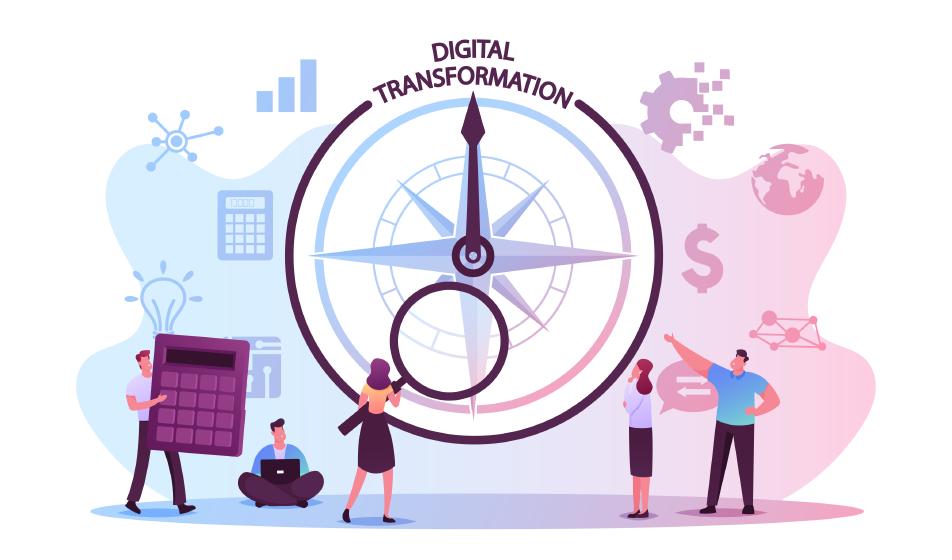Implementing a digital transformation strategy is vital to SME success– reducing costs, streamlining processes & staying competitive in the increasingly technological business landscape.
In this blog, we’ll look at how a digital transformation can supercharge your small business. We’ll also provide practical steps on the process, with expert advice from our HR Partner, Karen Falconer, HR Knowledge Manager at HR Solutions.
What is a digital transformation?
How can a digital transformation help SMEs?
6 steps to implementing a digital transformation strategy
Where digital transformation can go wrong (Employment Tribunal)
The future is digital
What is a digital transformation?
A digital transformation is the use of digital technologies to transform how a business operates, either by implementing new systems and technologies, or by improving older processes.
How can a digital transformation help SMEs?
A digital transformation can supercharge a small business in the following ways:
Efficient digital processes can help to increase or improve your product offering to customers & clients.
“Undergoing a digital transformation can hugely improve efficiency for a small business, especially when it comes to automating processes in areas like recruitment and compliance,” Karen Falconer of HR Solutions advises.
“For example, the ability of recruitment software to filter applications by criteria and to get to the applications you need, quickly, can save SMEs a lot of valuable time. Some recruitment software packages even offer the ability to remove personal data, so you can just focus on the person’s answers. This also allows for the elimination of unconscious bias.”
-
Increased security & reduced costs
Storing data digitally (if you don’t already) can help to keep files securely in the cloud rather than in a filing cabinet.
“Digital storage allows you unlimited secure storage, saving you time and money. Storing files physically is costly & doesn’t allow easy access,” Karen Falconer of HR Solutions advises.
“It also makes compliance much easier. It’s easier to maintain data protection & to comply with the principles of data minimisation - only collecting the information you need to collect. It’s quicker to update employee personal data & makes storage limitation easier to manage when data is centralised. You’re also keeping your information at less risk from theft & fire when storing files digitally.”
Find out how to securely store your employee data with Breathe.
6 steps to implementing a digital transformation strategy
It can be hard to know where to start when considering updating business processes in this way. So, where should small businesses begin? We asked our HR expert, Karen Falconer.
Here are 6 steps for SMEs to implement a digital transformation:
1. Work out your baseline
“SMEs all have different starting points,” Karen notes. “It depends how tech-literate you are as a business already. For small businesses that don’t know where to begin, a good starting point is usually considering your customer/end user’s experience. Work backwards from there in deciding on your strategy and how your people are able to provide that experience and get to that stage.”
You first need to understand what is and isn’t working across different areas of the SME. Speak to teams and find out exactly what they need to perform their jobs more efficiently/what would help them.
“Assess what the current capabilities of your existing hardware & software are,” Karen Falconer advises. “Work out what is – and isn’t working well, to create your baseline. This will be the point that you start from.”
2. Research & define your goals
Although this takes time (that a lot of SMEs may not feel they have), committing to & investing in the research phase is crucial to discover the technologies that will most advantage your teams & give them the best data to achieve more in their roles/improve productivity.
“Horizon-scan to work out what’s coming up in your industry, and what might really benefit your business. Now’s the time to work out what your goals are - lavish ideas aren’t very helpful when you haven’t worked out what you actually need from the technology.” Karen Falconer, HR Solutions.
If you’re struggling to find time to research or to even consider a project like a digital transformation, there are smaller tasks you can do regularly to keep up-to-date.
“Keeping up-to-date with current trends & competitors in your industry will help with ongoing, day-to-day research that could spark ideas or raise awareness of new developments,” Karen advises. “New employees joining the business and customers or clients will have an expectation of a certain level of continuous progress, so SMEs will need to keep up with their peers & what tech should be utilised.”
Knowing about the latest technologies in your industry will allow your SME to retain a competitive edge - especially important in the current economic climate.
3. Encourage collaboration
Getting departments communicating & talking to each other is important, to ensure alignment. “Set up a working party,” advises Karen Falconer of HR Solutions. “Put a team together from relevant areas of the business. You’ll need to include those that use the tech every day [that you’re considering changing].”
It’s also important to make sure your team understands the process & to achieve buy-in. “Ensure people can see that you’re trying to improve their working life – it’s in everyone’s interests to try and make the digital transformation a success.”
Providing employees with technologies to help them work better isn’t only likely to increase productivity, but employee engagement. Employees are more likely to engage further with their job roles when the quality of their tools & systems improve.
4. Don’t forget - or neglect - your culture
Karen believes that implementing strategic changes such as this is where the culture of an SME becomes clear.
“Although lots of people struggle with change, you want your team to be enthusiastic about changes for the better. Make sure you listen to people’s ideas and give your staff time & attention during this process. Along with making them feel valued, this will encourage a better transition.”
Implementing a digital transformation means you’re likely to experience some resistance to change – but truly resilient cultures will be able to overcome these challenges. This ties back into your company culture, and as long as you remember to put your people first, you’re on the right track.
5. Upskill your team
An important (but often overlooked) phase of a digital transformation is the training phase. It’s all very well having audited, researched & purchased new technology to make your business processes better, but if your team don’t understand how to use it, you could fall at the final hurdle.
“It’s so important not to assume your staff will know how to use new technologies or systems,” Karen advises. “Don’t presume they’ll all be able to use it, or to work it out. Younger people may be seen as more intuitive with tech - meaning if you don’t offer training, you could be left open to age discrimination accusations. Ensure your team have the support they need to use any new systems.”
6. Implementation phase
The implementation stage is where you’ve worked out costs & budget, signed off on new systems and your employees know how to use it. Now’s the time to roll this out to your business. Karen Falconer offers one final piece of advice to SMEs at this stage of a digital transformation.
“Make sure you’ve shopped around as much as you can and have focussed on the areas that are most important to your SME – whether it’s streamlining your processes, data security, quality customer service for the best experience. This is an important consideration before you reach that crucial purchase point and begin implementing the systems.”
Where digital transformation can go wrong
Updating your business processes with technology doesn’t always go as planned. Uber had an indirect discrimination claim and a (racial) harassment claim brought against them in 2021 after they introduced facial recognition to their employee app.
Pa Edrissa Manjang was dismissed by Uber after the facial recognition software failed to recognise him when he tried to sign into the app to work. Pa Edrissa Manjang claims that he was dismissed due to racially biased facial recognition technology, and that the excessive verification checks the facial recognition software demanded amounted to racial harassment.
Uber have requested that the discrimination claim be struck out by the Employment Tribunal, but the Employment Tribunal haven't agreed to this, and will hear the claims.
Karen Falconer referenced this case, stating its significance. “It’s crucial to ensure a person is checking the technology’s decisions, especially before you prevent someone’s access to work.”
This is something businesses should always consider when digitalising processes, especially those around employees’ access to work.
The future is digital
Whilst technology is important, Karen reminds SMEs not to forget about their greatest asset. “Successful SMEs are experts in their own industries – and that comes from their people,” Karen notes.
“I can’t emphasise enough how employers are going to need to embrace AI – so many aren’t aware of the fact that it’s here already. Alongside the potential of your people, technology will again revolutionise the world of work. Automation is going to increase productivity exponentially, and millions of jobs will need to be re-imagined – which is exciting.”
Karen Falconer is the HR Knowledge Manager at HR Solutions.
Find out how Breathe can help to centralise your employee data & reduce the time you spend on admin.
With fast implementation & set-up times, why not trial for free for 14 days?






